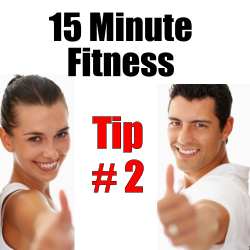In today’s information society, you probably are well aware that exercise is the hallmark of a fit and healthy individual.
Today’s sedentary lifestyles can be dangerous and even deadly, but how much exercise is enough to significantly impact your fitness and health levels? And if you are just starting out, what can you reasonably do to make a difference?
With more than 80% of all Americans getting less than the required amount of exercise every year, it is crucial that you know exactly what you need to do to positively impact your overall health and longevity.
One major study showed that individuals who exercised intensely for 30 minutes per day actually got better health benefits than those who performed the same exercises for one hour a day. This seems to support other studies which claimed that 30 minutes of moderately intense activity or exercise significantly boosts our immune systems, and is the minimum daily requirement for physical fitness.
The good news is that sedentary individuals can break up those 30 minutes a day down into easier to swallow bite-sized chunks. So, you’ll need to set your schedule for three times a day of 10 minutes of uninterrupted, moderate to intense exercises.
Starting Out Getting Enough Exercise
Just be sure that if you are starting out from a very inactive lifestyle, stretch first, and do not overdo yourself. When just beginning, touching your toes, doing deep knee bends, or performing a few jumping jacks will be enough to get your heart rate up.
Also, the average person can briskly walk at a rate of between 3 and 4 miles per hour, meaning a quick paced one mile walk can be accomplished in just 15 to 20 minutes.
Stand More Whenever You Can
This is something which is feasible for just about everyone, and can be added to your work and home schedules easily. But why is exercise so important? The World Health Organization and other major fitness minded institutions have linked breast cancer, colon cancer, diabetes, obesity and several heart diseases to a sedentary lifestyle that features sitting as a prominent feature. So remember, “Stand when you can.”
If you are getting 30 minutes of medium to intense physical exercise every day, pat yourself on the back. You are doing what is minimally required to live a fit and healthy lifestyle. And if you are not currently getting at least one half hour of exercise a day, it is never too late to start. Get out of your chair and on your feet for at least 30 minutes of exercise per day, and you can avoid the many dangers which a sedentary lifestyle delivers.
10-Minute Verses 30-Minute Workouts
As busy working professionals, finding a 30-minute block of time each day is not always easy. However, almost everyone can find three 10-minute blocks of time per day. But then the question begging to be asked is “Are three 10-minute workouts as beneficial as one 30-minute?” According to exercise experts, the answer is “Yes” and in many cases, three shorter workouts are more beneficial than a longer one.
10-Minute Workout Health Benefits
There are several health benefits derived from multiple, but short, exercise sessions:
- increased metabolism
- heart health
- weight maintenance
Increased Metabolism
Various studies have shown that three short blasts of intense exercise boosts your metabolism more, and keeps it higher longer, than a long but less intense workout.
Heart Health
And shorter workout sessions benefit heart health too. According to a study done by the Healthy Lifestyles Research Center at Arizona State University, fractionated exercising was more effective at lowering high blood pressure than longer sessions.
Weight Maintenance
Short workout sessions are great for maintaining your weight or maybe even losing a few pounds. Because most 10-minute sessions concentrate on cardio training, not only are you burning calories while exercising, but as noted above, you keep burning more calories longer due to an increased metabolism.
30-Minute Workout Health Benefits
While three 10-minutes exercise sessions do have their advantages, one 30-minute session per day works better for some people for these reasons:
- available time
- strength training
- losing weight
Available Time
For some working people, especially those with long commutes, it is actually easier to exercise for 30-minutes during the middle of the day than it is to do it either before leaving for work or after getting home.
Strength Training
Weight training lends itself better to longer workout sessions. One way of burning more calories is to increase your lean muscle mass, but in order to do that, you have to do strength training. More muscle mass means you will burn more calories in a given period of time.
Losing Weight
To lose weight, you have to get your body into the “fat-burning mode”. This usually happens at about 20 minutes into your workout, so you can get a good 10 minutes of “burn” in a 30 minute workout; if you are doing 10-minute workouts, you never get to that point.
Doing Both Workouts
Because a balanced weekly workout should include both strength training and cardio, you can get the best of both worlds by doing three 10-minute workouts four days a week and one 30-minute workout each day on the weekend. That way you get both types of training in a full week and still get one day of rest. We already discussed “6 Reasons Not to Skip Your Workout” and next we’ll dive into “Exercise Tips for Those Who Live Sedentary Lifestyles” and some everyday tasks that you can turn into a workout.









